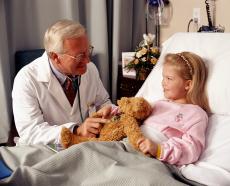 |
 |
 |
Other Health Topics:

-
Related Topics
-
Go Local
- Services and providers for Cancer in Children in the U.S.
-
National Institutes of Health
- The primary NIH organization for research on Cancer in Children is the National Cancer Institute
Cancer begins in the cells, which are the building blocks of your body. Normally, new cells form as you need them, replacing old cells that die. Sometimes, this process goes wrong. New cells form when you don't need them, and old cells don't die when they should. The extra cells can form a tumor. Benign tumors aren't cancer while malignant ones are. Malignant tumor cells can invade nearby tissues or break away and spread to other parts of the body.
Children can get cancer in the same parts of the body as adults, but there are differences. Childhood cancers can occur suddenly, without early symptoms, and have a high rate of cure. The most common children's cancer is leukemia. Other cancers that affect children include brain tumors, lymphoma, and soft tissue sarcoma. Symptoms and treatment depend on the cancer type and how advanced it is. Treatment may include surgery, radiation and/or chemotherapy.
National Cancer Institute
-
Care for Children and Adolescents with Cancer: Questions and Answers
 (National Cancer Institute)
(National Cancer Institute)
Also available in Spanish
-
Childhood Cancer(Nemours Foundation)
Also available in Spanish
-
Young People with Cancer: A Handbook for Parents
 (National Cancer Institute)
(National Cancer Institute)
| Basics | Learn More | Multimedia & Cool Tools |
|---|---|---|
|
||
| Research | Reference Shelf | For You |
-
Overviews
- Children and Cancer: Information and Resources(American Cancer Society)
-
Latest News
- One-Fifth of British Childhood Cancer Survivors Smoke(08/06/2008, HealthDay)
- Immunotherapy Boosts Treatment of Kids' High-Risk Sarcomas(08/04/2008, HealthDay)
-
Treatment
-
Chemotherapy(Nemours Foundation)
Also available in Spanish
- Childhood Cancer Treatment(Children's Oncology Group, National Childhood Cancer Foundation)
-
Childhood Extracranial Germ Cell Tumors (PDQ): Treatment
 (National Cancer Institute)
(National Cancer Institute)
Also available in Spanish
-
Radiation Therapy(Nemours Foundation)
Also available in Spanish
-
Unusual Cancers of Childhood (PDQ): Treatment
 (National Cancer Institute)
(National Cancer Institute)
Also available in Spanish
-
Chemotherapy(Nemours Foundation)
-
Nutrition
- Nutrition for Children with Cancer(American Cancer Society)
-
Coping
- Dealing with Diagnosis of Cancer in Children(American Cancer Society)
- Helping the Sibling of the Child with Cancer(Cancer Care, Inc.) - Links to PDF
-
Specific Conditions
- Germ Cell Tumors - Childhood(American Society of Clinical Oncology)
- What Are the Types of Childhood Cancers?(American Cancer Society)
-
Related Issues
- Childhood Cancer: Late Effects of Cancer Treatment(American Cancer Society)
- Children Diagnosed with Cancer: Returning to School(American Cancer Society)
- Children Diagnosed with Cancer: Understanding the Healthcare System(American Cancer Society)
- For Kids with Cancer, It's Always Back-to-School Season(American Cancer Society)
-
Late Effects of Treatment for Childhood Cancer (PDQ)
 (National Cancer Institute)
(National Cancer Institute)
Also available in Spanish
-
Financial Issues
- Financial Issues (Cancer in Children)(American Cancer Society)
- What Types of Insurance Are Available? (Cancer in Children)(American Cancer Society)
-
Clinical Trials
-
Children's Assent to Clinical Trial Participation
 (National Cancer Institute)
(National Cancer Institute)
-
ClinicalTrials.gov: Cancer in Children

-
How to Find a Cancer Treatment Trial
 (National Cancer Institute)
(National Cancer Institute)
-
Children's Assent to Clinical Trial Participation
-
Research
-
Childhood Cancer Trial Results
 (National Cancer Institute)
(National Cancer Institute)
-
Childhood Cancers: Questions and Answers
 (National Cancer Institute)
(National Cancer Institute)
-
Childhood Cancer Trial Results
-
Journal Articles
References and abstracts from MEDLINE/PubMed (National Library of Medicine)
- Article: A video game improves behavioral outcomes in adolescents and young...
- Article: A writing workshop for children with cancer.
- Article: Part I: Cancer in Indigenous Africans--burden, distribution, and trends.
- Cancer in Children -- see more articles
-
Dictionaries/Glossaries
-
Dictionary of Cancer Terms
 (National Cancer Institute)
(National Cancer Institute)
-
Dictionary of Cancer Terms
-
Directories
-
Cancer Genetics Services Directory
 (National Cancer Institute)
(National Cancer Institute)
- Find a Pediatric Hematologist/Oncologist(American Society of Pediatric Hematology/Oncology)
-
National Cancer Institute Cancer Centers Program
 (National Cancer Institute)
(National Cancer Institute)
Also available in Spanish
- Resource Directory (Childhood Cancer)(Children's Oncology Group, National Childhood Cancer Foundation)
-
Cancer Genetics Services Directory
-
Organizations
- American Cancer Society
- CureSearch(Children's Oncology Group, National Childhood Cancer Foundation)
-
National Cancer Institute

-
Children
-
Chemotherapy(Nemours Foundation)
Also available in Spanish
-
Radiation Therapy(Nemours Foundation)
Also available in Spanish
-
Some Kinds of Cancer Kids Get(Nemours Foundation)
Also available in Spanish
-
What Is Cancer?(Nemours Foundation)
Also available in Spanish
-
Chemotherapy(Nemours Foundation)
-
Teenagers
-
Cancer Basics(Nemours Foundation)
Also available in Spanish
-
Chemotherapy(Nemours Foundation)
Also available in Spanish
-
Dealing with Cancer(Nemours Foundation)
Also available in Spanish
-
Radiation Therapy(Nemours Foundation)
Also available in Spanish
-
Types of Cancer Teens Get(Nemours Foundation)
Also available in Spanish
-
Cancer Basics(Nemours Foundation)
| Home | Health Topics | Drugs & Supplements | Encyclopedia | Dictionary | News | Directories | Other Resources | |
| Copyright | Privacy | Accessibility | Quality Guidelines U.S. National Library of Medicine, 8600 Rockville Pike, Bethesda, MD 20894 National Institutes of Health | Department of Health & Human Services |
Date last updated: 11 September 2008 Topic last reviewed: 11 September 2008 |






